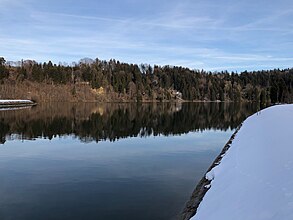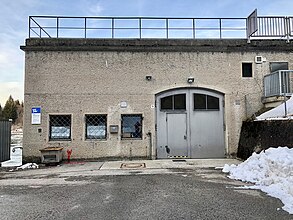Lech stage 8 - Sparrowhawk
| Lech stage 8 - Sparrowhawk | ||
|---|---|---|
| View from the west | ||
| location | ||
|
|
||
| Coordinates | 47 ° 51 '45 " N , 10 ° 55' 26" E | |
| country | Germany | |
| place | Hohenfurch | |
| Waters | Lech | |
| Kilometers of water | km 116.0 | |
| Height upstream | 659 m above sea level NHN | |
| power plant | ||
| operator | Uniper power plants | |
| Start of operation | 1947 | |
| technology | ||
| Bottleneck performance | 7.3 megawatts | |
| Average height of fall |
7.5 m | |
| Expansion flow | 120 m³ / s | |
| Standard work capacity | 33.9 million kWh / year | |
| Turbines | 6 Strafloturbines | |
| Generators | 6 outer rim generators | |
| Others | ||
| was standing | 2019 | |
The Lech barrage 8 - Sparrowhawk is a barrage of the Lech between Schongau and Landsberg and is located at river kilometer 116.0 in the municipality of Hohenfurch in the district of Weilheim-Schongau .
The barrage is located in the Steilhalden and Lech River Meadows nature reserve between Kinsau and Hohenfurch .
history
As early as 1938, the expansion of hydropower in Bavaria was planned for the first time by the German Reich and the State of Bavaria . While Bayernwerk AG initially planned the construction of conventional run-of-river power plants , the head of the Supreme Building Authority in the State Ministry of the Interior, Arno Fischer , was able to carry out the expansion on the basis of the underwater construction method he developed according to the "Schwede-Coburg-Fischer" system with the help of his party friend Franz Schwede -Coburg and the NSDAP prevail. The advantage of this design was the camouflage , which was important for the war effort , the few roof areas were greened and the power plant itself could be completely overflowed by the Lech by lowering the dams. The cost savings that were also propagated later turned out to be a miscalculation.
Bayerische Wasserkraft AG, or BAWAG for short, was founded on January 26, 1940 to expand the power plants. A third of the share capital each belonged to the state of Bavaria, RWE and VIAG .
Initially, Arno Fischer planned to complete twenty barrages by 1942, but construction began in the summer of 1940 initially at six locations (Lech barrages 9 , 11 , 12 , 13 , 14 , 15 ).
Field railways and access roads were created for the transport of materials . First, sheet pile walls were erected around the area of the later power plant buildings, after which the gravel bed of the Lech within the excavation pit was removed down to the bedrock. Then the shuttering work for the concrete and reinforced concrete began, the hammering in of the sheet piling for the dams , the concreting of the dam base and the rest of the embankment.
In 1943, levels 11, 12, 13 and 15 were connected to the grid, and levels 9 and 14 followed in 1944. The originally calculated construction costs had already tripled by this point. Levels 7 , 8 and 10 of the same design were not completed until after the Second World War 1947–1950.
In 1994 all of the power plants came to VIAG, in 2000 to E.ON and finally in 2016 to Uniper Kraftwerke .
The power plant's concession runs until 2030.
technology
The generated output of Lech barrage 8 is 7.3 MW with a drop height of 7.5 meters.
In the " Arno Fischer power plant construction " weir and power plant form a common structure, the weir flap has 8 attached flaps with a total width of 76 m, four bottom outlets and an engine room integrated in the weir .
Within the power plant are nacelle cranes with which all removable parts of the plant can be promoted to the border area, this large loading gate was installed on one side in all power plants.
The power plant has six Strafloturbines and six machine sets arranged in parallel .
Each turbine has a flap in the inlet area and a contactor in the outlet area. These locking mechanisms make it possible to dry the turbines individually for inspection purposes and to walk through them. A total of four lower-lying bottom outlets are arranged between the six turbine sets in order to divert the sediment transported during floods safely into the underwater .
The generator itself is arranged as a watertight encapsulated outer ring generator , the rotor is firmly connected to the impeller . However, the problem here is the sealing of the turbines from the generators, as well as the practical impossibility of adjusting the impeller. Rigid propeller impellers are therefore installed in the Arno Fischer design. In principle, this limits the efficiency in the partial load range, but the poor partial load efficiency of the propeller turbines can be compensated relatively well by staggering the machines in operation.
The expansion flow of the power plant is 120 m³ / s, the standard energy capacity 33,933 MWh per year.
See also: List of hydropower plants in Germany
Reservoir
The reservoir to the south is about 3.7 km long and 0.3 km wide, it covers about 70 hectares. The about 300 m long dam on the west bank has a concrete dam base. The lake lies in a deep valley, to the east the terrain rises to almost 770 m, to the west to almost 790 m.
The Schönach flows from the left and the Wielenbach from the right into the reservoir.
Individual evidence
- ↑ Martin Gschwandtner: Once upon a time there was a «coal theft» technology under the yoke of the Nazi dictatorship; Arno Fischer and the wrong track of the “underwater power plants” in the period between 1933 and 1945 . GRIN, Munich 2009.
- ↑ Bayerische Wasserkraftwerke Aktiengesellschaft (ed.): 50 years of nature and energy in harmony, 1940-1990 . Munich 1990.
- ↑ Bayerische Wasserkraft AG: The Lech and the Lech expansion . Munich 1988.
- ^ Bavarian State Office for Water Management: 100 years of hydraulic engineering on the Lech . tape 19 . Munich 1984, p. 58 .
- ↑ Christine Kamm: Written request BÜNDNIS 90 / DIE GRÜNEN: Rights to the use of hydropower on the Lech near Augsburg by EON. February 8, 2010, accessed February 16, 2019 .
- ↑ Anton Lichtenstern, Thomas Wunder: The steam hammer worked day and night. September 5, 2015, accessed February 13, 2019 .
- ^ Canaan: The underwater power plant . 1945.
- ↑ Arno Fischer: Imperial patent 760140 - Floodable river power plants. November 24, 1944. Retrieved February 17, 2019 .
- ↑ Andreas Ringler: Floodable river power plants. 2016, accessed February 13, 2019 .
- ↑ Analysis of the use of hydropower in Bavaria. Retrieved January 19, 2019 .
- ^ BayernAtlas. Retrieved February 17, 2019 .





